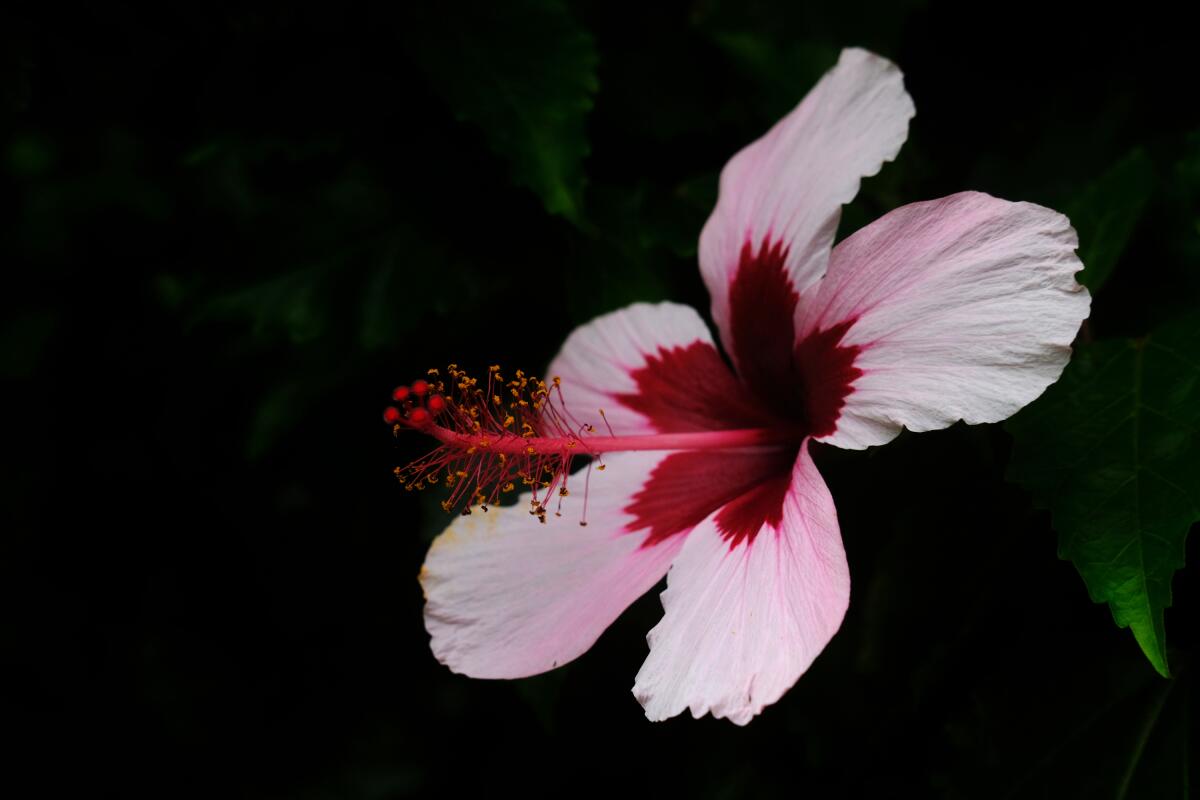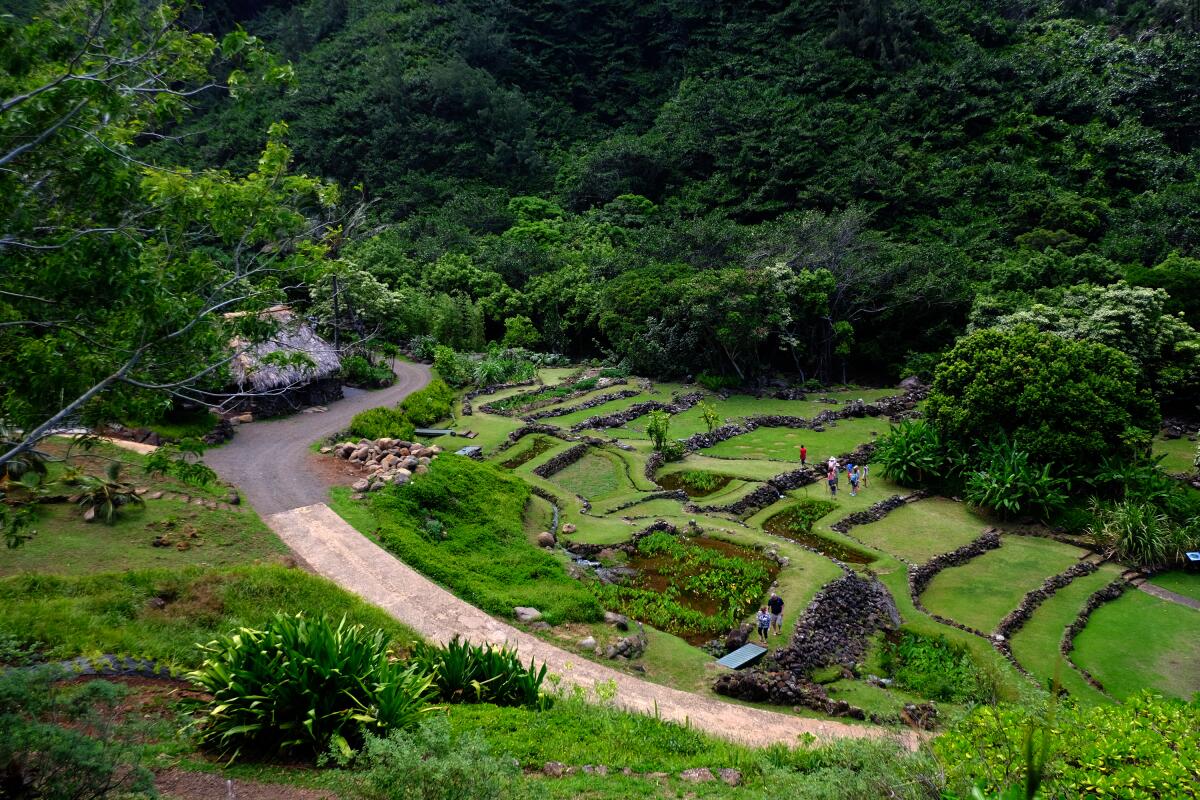Sign up for The Wild
We’ll help you find the best places to hike, bike and run, as well as the perfect silent spots for meditation and yoga.
You may occasionally receive promotional content from the Los Angeles Times.
Haena, Hawaii — Haena State Park, the gateway to Kauai’s Napali Coast, has reopened more than a year after heavy rains spawned floods that damaged or destroyed nearly 400 dwellings on the island.
The April 2018 deluge caused millions of dollars of damage and triggered landslides that blocked the only road to the park.
While repairs were underway, residents and officials had a chance to catch their breath, look to the future and ask difficult questions, including this one: Is tourism wrecking Kauai?
“Over the past decade, as our visitor numbers exploded on Kauai, this area became so overrun that it was impossible for residents to come and use it,” said Chipper Wichman, president of the National Tropical Botanical Garden, which includes Limahuli Garden & Preserve in Haena.

“For many of us, the flood was more than just a flood. It was some form of divine intervention.”
That intervention was not without earthly problems as residents grappled with how to protect the land, the people and the visitor experience.
Kauai now is juggling what other tourist magnets around the world have been trying to cope with: How does a destination share its charms and simultaneously avoid being loved to death?
As Kauai’s popular attractions were preparing to reopen in the spring, I visited the North Shore to learn more about a long-in-the-making tourism master plan that aims to balance all the needs a place as special as this one engenders.
Haena State Park, about a 30-minute drive from Princeville, is located at the end of Kuhio Highway in the northwestern corner of Kauai. Limahuli Garden & Preserve is on the mauka (mountain) side of the road and adjacent to the park, which is on the makai (ocean) side of the road. The Kalalau Trail starts in Haena State Park and takes you to the Napali Coast State Wilderness Park.
The area’s dramatic mountains, waterfalls and beaches seem almost like a movie set; in fact, they have starred in “Jurassic Park,” “Pirates of the Caribbean: On Stranger Tides” and “The Descendants,” among others.
It’s no wonder people want to explore an area that seems like nature’s version of a treasure chest.
The changes at Haena State Park are part of a movement, in Hawaii and elsewhere, to manage overtourism. The park used to see 3,000 visitors a day. That number now is capped at 900. That means planning and making online reservations for admission and parking are imperative.
Because parking is limited, visitors are encouraged to use the Kauai North Shore Shuttle, which runs between Princeville and the park. Don’t even think of driving to the end of Kuhio Highway and parking along the road. If you do, you’ll face some hefty fines and your vehicle could be towed.
Access to the park begins at the parking lot, where a boardwalk takes you through ancient Hawaiian kalo (taro) patches and terraces.
“I want [visitors] to be able to stand here on this boardwalk and take a deep breath and feel the essence of this place and feel the spirit of this place,” said Wichman, who was a driving force behind the master plan.
“Previously, it may have simply been the gateway to the Napali Coast. I hope that what [visitors will] now experience is that they’re stepping onto a land that has nurtured our community for a thousand years.”
Cities and attractions in countries around the world are too well-loved by tourists. Here’s what some are doing about it.
The park, which I first visited a decade ago, has been transformed, and I soaked in its serenity and beauty. A new path provides a stunning view of the mountain known as Makana, which moviegoers know as Bali Hai from the 1958 film “South Pacific.”
As the boardwalk ends, the route turns into a path made of crushed coral and takes you through a forest of hau trees, a shady respite.
On a walk to Kee Beach, which takes less than 10 minutes, I was joined by Alan Carpenter, Hawaii State Parks assistant administrator, who pointed out the core of the overuse problem.
“You have this world-famous Kee Beach, this little lagoon, and right next to it ... you have the trailhead to one of the most famous trails on the planet,” Carpenter said. “These ... things combined is what brings everybody to this place.”
Nearby, the trailhead to the Kalalau Trail in the Napali Coast State Wilderness Park beckoned. It was closed for repairs the day I was there but has since reopened.
Most experienced hikers in good shape can hike the first two miles of the 11-mile trail, but beyond that you need to be an accomplished hiker who can handle multiple stream crossings. Trails along this coast can go from doable to dangerous during heavy rain, which is frequent.
But if you have the skills, you’ll be rewarded with views of the Napali Coast, known for cliffs that rise as much as 3,000 feet, lush valleys and pristine beaches. It is a visual superstar, one of the most photographed coastlines in the world.
The new park experience evokes what life was like for the early Hawaiians, who were self-sufficient, fishing and farming taro.
“We’re the people of the land, the eyes of this place and the resources,” said Presley Wann, president of the Hui Maka‘ainana o Makana, the nonprofit group that restored the taro patches. Under a curatorship agreement with the park, the Hui volunteers have been taking care of the place for the past 20 years and perpetuating Hawaiian values, including stewardship of the land and the sea.
For a couple of weeks after the flood, the ocean and taro patches provided the only sources of food for the community, besides the food that was brought in by boat and helicopter.
The Hui members are passionate about passing on the old ways to members of the younger generation.

“I want to share with them, so that they can carry on after us,” said Hui member William Kaleo Kinney Sr. “It’s a very sacred place.”
After cooling off in the shadow of Makana, I also visited Limahuli Garden & Preserve, known as “the window to old Hawaii.” You can walk along ancient taro terraces built a thousand years ago, and you’ll also see endangered plants you’ll see nowhere else.
The botanical garden and nature preserve is set in the verdant 1,000-acre Limahuli Valley. As I listened to the refreshing sound of Limahuli Stream, I savored my time in Haena and was grateful for the chance to reconnect with nature.
“We can be a model for the world in how we take care of this special place,” Wichman told me. “It’s really important for our visitors and our community to work together to create this vision of sustainable tourism.”

Sign up for The Wild
We’ll help you find the best places to hike, bike and run, as well as the perfect silent spots for meditation and yoga.
You may occasionally receive promotional content from the Los Angeles Times.